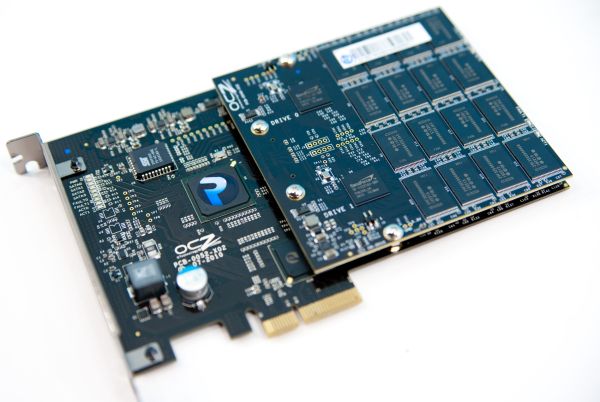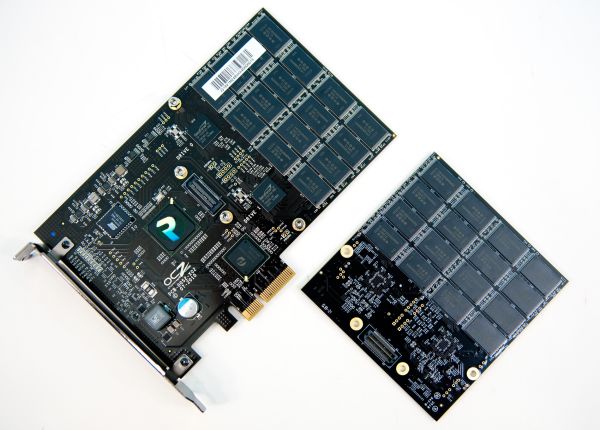A Quick Look at OCZ's RevoDrive x2: IBIS Performance without HSDL
by Anand Lal Shimpi on November 4, 2010 1:05 AM EST- Posted in
- Storage
- SSDs
- OCZ
- RevoDrive
- RevoDrive x2
A week after I previewed OCZ’s IBIS and the HSDL interface, SandForce revealed the specs of its next-generation enterprise SSD controller. The specs for the SF-2000 series call for up to 500MB/s sequential reads and writes, nearly saturating the newly introduced 6Gbps SATA bus. It should be no surprise that OCZ is very interested in moving away from SATA.
We met OCZ’s first PCIe based SSD two years ago with the Indilinx based zDrive. Take four Indilinx Barefoot controllers, RAID them together on a PCIe card and you’ve got a zDrive. The first SandForce based PCIe solution actually took a step backwards: the OCZ RevoDrive only used two SandForce SF-1200 controllers.
Performance was of course much better than the old zDrive. SandForce has all but put Indilinx out of our minds (and systems). But the recently announced IBIS and the suspicious unpopulated connector on the original RevoDrive made it clear that there was room for more performance.
Meet the RevoDrive x2:
Identical to the original RevoDrive in every way, the x2 adds a second PCB complete with two more SF-1200 controllers. With a total of four SF-1200s on board, running in RAID-0, you should get IBIS-like performance without the HSDL interface.
The architecture remains unchanged. To save on costs OCZ uses a PCI-X based RAID controller: the Silicon Image 3124. The 3124 has four independent SATA ports, each one connects to a SF-1200 controller.
Between the Sil3124 and the PCIe x4 interface is a Pericom PCI-X to PCIe bridge. It converts the parallel PCI-X signaling into serial PCIe. The Sil3124 can deliver 1GB/s of bandwidth to the Pericom bridge, as can the 4 PCIe lanes (1GB/s in each direction) so there are no interface bottlenecks here. A quartet of SF-1200 controllers can’t realistically push more than 1GB/s of data.
As with all RAID enabled solutions, there’s no TRIM support but you do get idle garbage collection.
There’s no performance advantage over you running four of your own SF-1200 based SSDs in RAID-0. The RevoDrive x2 is pretty much a four drive SF-1200 SSD on a stick for those who want simplicity.
The previous RevoDrive was supposed to be cost competitive with a two drive RAID array. Today, looking at pricing, a 240GB RevoDrive sells for $519 while a pair of 120GB Vertex 2s will set you back $480. You pay a premium for the simplicity but performance is identical to rolling your own SSD RAID setup.













46 Comments
View All Comments
jav6454 - Thursday, November 4, 2010 - link
800MB/s Sequential and almost 600MB/s random?! I now wonder where my piggy bank is?In all seriousness, OCZ has got a winner here, the only thing I do regret is having few PCIe ports... hopefully the HD6900s series will help open up a port.
DanNeely - Saturday, November 6, 2010 - link
AFAIK A 32 deep IO Queue isn't something you're going to see outside a heavily loaded server. The 150/200 on random and 320/380 on sequential are more in line with what a typical end user will get.Out of Box Experience - Wednesday, November 17, 2010 - link
I think these Indilynx controllers might be faster than Sandforce for REAL workloads like COPY & PASTE under XP!I wish Anand would directly compare copy/paste speeds of both SATA and PCIe SSD's under XP as that IS the Number One Operating System for the forseeable future!
I think that how an SSD handles non-compressible data or data already on the drive are the most enlightening tests one could do to directly compare SSD Controllers under common workloads
Now, if OCZ could just make their stuff plug and play under XP without all the endless tweaks, or OS upgrades, we'd have a winner untill Intel starts making PCIe SSD's
Chant in unison....
Plug & Play Plug & Play Plug & Play Plug & Play Plug & Play
mr woodstock - Friday, November 19, 2010 - link
XP is still number one .... for now.Windows 7 is selling very fast, and people are upgrading constantly.
Within 3-4 years XP will be all but a memory.
boe - Thursday, November 18, 2010 - link
I agree about PCIe ports. I could swing one x4 or faster PCIe port however since I need about 2TB of storage I'll be needing a lot more slots!mianmian - Thursday, November 4, 2010 - link
Using such a small connector to mount the daughter card seems not that reliable. I looks going to fall apart someday.puplan - Thursday, November 4, 2010 - link
There is nothing wrong with the connector. The daughter board is held by 4 screws.GeorgeH - Thursday, November 4, 2010 - link
I don't see any real reason to doubt that 4x Vertex 2s would perform identically, especially with a discrete RAID card of reasonable quality, but has it actually been verified on the integrated RAID that comes with a "performance mainstream motherboard", both AMD and Intel?It wouldn't be incredibly surprising to me to see some previously unknown performance reducing bugs crop up when you start pushing the kinds of numbers we're seeing here with integrated RAID solutions.
Minion4Hire - Thursday, November 4, 2010 - link
Yea, I thought that the max combined bandwidth from ICH10 was something like 660MB/s...?disappointed1 - Thursday, November 4, 2010 - link
"ICH10 implements the 10Gbit/s bidirectional DMI interface to the "northbridge" device."That's 1.25GB/s bidirectional